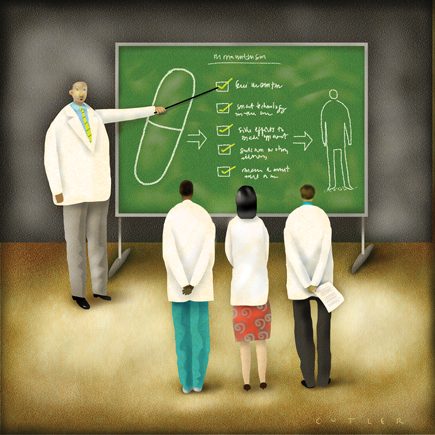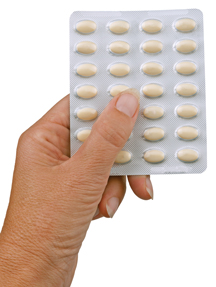‘Unlearning’ how to prescribe antibiotics
Health care leaders have spent endless hours trying to break a habit that's been surprisingly intractable: prescribing antibiotics when they're not warranted.
In the battle to stay ahead of antibiotic-resistant organisms, today's physicians can tap a growing array of clinical weapons, but long-entrenched prescribing habits have sometimes proven challenging to unravel.
Numerous strategies already have been launched. Hospital leaders and physicians have spearheaded antibiotic stewardship programs. Professional groups continue to publish clinical recommendations, including this spring's sinus infection guidelines from the Infectious Diseases Society of America (IDSA). Researchers are developing new rapid diagnostic tests and delving into the potential role of biomarkers, such as procalcitonin.

But new antibiotic options also are becoming scarcer even as resistant organisms proliferate. Sixteen new antibacterial agents were approved from 1983 to 1987, compared to five in 2003 to 2007 and just two from 2008 through mid-2012, according to an Archives of Internal Medicine commentary published in 2011, which calculated approvals across five-year intervals.
Doctors are taking such data to heart as they write new prescriptions, said Allan Joseph Morrison Jr., MD, FACP, an infectious disease specialist and hospital epidemiologist at Inova Fairfax Hospital in Falls Church, Va.
“There's the knowledge that the cupboard is bare—the bad bugs-no drugs phenomenon, which has been widely touted,” he said.
Also this summer, Congress passed legislation to foster new drug development. The antibiotic provisions, which fell under the Food and Drug Administration Safety and Innovation Act, included a five-year extension on exclusivity for new antibiotics and garnered the IDSA's support.
“It's a good first step,” although more legislation is needed to boost developmental incentives, said Robert Guidos, IDSA's vice president of public policy and government relations.
Thus, antibiotics will remain a scarce commodity for the foreseeable future, one that must be protected much like the nation's forests and other environmental resources, said Brad Spellberg, MD, FACP, an infectious disease specialist and associate medical director for inpatient services at Harbor-UCLA Medical Center in Torrance, Calif. And clinicians are failing to do so, he said, adopting a more pessimistic view than Dr. Morrison.
“I'm very hard pressed to identify widespread practice changes that have improved in recent times,” said Dr. Spellberg, who also authored the book “Rising Plague: The Global Threat from Deadly Bacteria and Our Dwindling Arsenal to Fight Them.”
“It's easy to say we need to protect antibiotics and nobody disagrees with that,” he said. “It's just hard to figure out how to do it. Changing human behavior is probably the single most difficult thing in public policy.”
Less can be more
The prescribing challenges can differ somewhat depending on where physicians treat patients. Those who practice in outpatient settings know that the overwhelming majority of walk-in patients suffer from a viral infection, Dr. Spellberg said. But with relatively few rapid diagnostic tests available, there's an understandable fear factor, he said.
The doctor can't help but worry, he said: “‘What about the 2% of the time that I'm not right, and it turns out to be a bacterial infection? Is something bad going to happen to that patient?’ Doctors often write that script just to be sure.”
Antibiotic use does decline when a rapid test is both available and routinely used, said Dr. Spellberg, pointing to a recent national campaign in France.
Prior to the start of the campaign, which promoted rapid strep tests along with a widespread educational effort, France had the highest rate of resistant Streptococcus pneumoniae in Europe, along with high rates of antibiotic prescribing. From 2002 to 2007, the number of antibiotic prescriptions written during the winter respiratory season decreased by 26.5%, according to results published in 2009 in PLoS Medicine.
Meanwhile, hospital-based physicians must strive to more quickly narrow the spectrum of antibiotics used once laboratory testing has identified the organism involved, Dr. Morrison said. “Unfortunate-ly many physicians take the position, ‘The patient is doing better, therefore I'll continue the same course.’”
Another poor practice: keeping patients on an antibiotic regimen longer than needed. “One of the strongest themes weaving its way through all of the more recent antibiotic-based guidelines is a less-is-more approach,” Dr. Morrison said.
Some of the underlying research dates back nearly a decade. Dr. Spellberg cited one study, published in 2003 in the Journal of the American Medical Association, which found that eight days of antibiotic treatment was just as effective as 15 days for adults with ventilator-associated pneumonia.
Not only were the mortality rates similar in the two groups, but the eight-day treatment group was less likely (42.1% vs. 62%) to develop a multiresistant organism if their pulmonary infection recurred.
The less-is-more approach also can be applied with some outpatient illnesses. In March, IDSA officials published their first guidelines on sinus infections, which they describe as the fifth leading source of antibiotic prescribing. In adults, they recommended five to seven days of antibiotics, rather than the 10-plus days that had been advised in other guidelines, as sufficient to combat an infection without encouraging resistance.
Since viruses cause 90% to 98% of sinus infections, IDSA officials also provided some guidance to sort out bacterial from viral. Among potential bacterial red flags: symptoms persisting at least 10 days without improvement, or signs of a worsening infection, such as a fever of 102-plus degrees, increased nasal discharge and facial pain lasting at least three days.
Prescribing stewardship
Hospital-wide initiatives also can reduce excessive prescribing, said Dr. Spellberg, citing an effort by Denver Health in Colorado to more effectively treat skin infections as one example.
Prior to instituting a clinical guideline protocol, the public hospital system had identified the use of too many broad-spectrum antibiotics, as well as unnecessarily long treatment for patients with cellulitis or cutaneous abscesses, according to findings published in 2010 in Clinical Infectious Diseases.
The new guideline, developed by a Denver Health working group, recommended vancomycin and discouraged drugs with broad aerobic gram-negative or anaerobic activity. No more than seven days of antibiotics was advised, unless the infection proved severe or didn't respond.
During the one-year intervention period studied from July 2009 to July 2010, vancomycin use increased to 93% compared with 75% for the baseline year, according to findings published in 2011 in Archives of Internal Medicine. Prescribing of other drugs declined and shorter regimens were more typical. More than one-third of patients, 38%, were given antibiotics for fewer than 10 days compared with 14% in the baseline group.
Despite its successes, the single-center study also highlights ongoing hurdles for clinicians, said Dr. Spellberg, who wrote the accompanying Archives editorial. Nearly 20% of patients, he noted, were still prescribed an antipseudomonal agent.
In Northern California, Kaiser Permanente's antibiotic stewardship program also grew out of some worrisome data. In 2004, an internal analysis conducted at Kaiser Permanente Vallejo Medical Center determined that there wasn't any clinical justification for 20% of the carbapenem agents that were being prescribed, said Stephen Parodi, MD, ACP Member, chair of infectious disease for Kaiser Permanente's Northern California Region.
“Most of the time, the physicians wanted to make sure that they were covering their bases and covering all of the types of bacteria that could be potentially causing infection in that patient,” he said. “It wasn't done with any malice.”
Bacteria resistant to the broad-spectrum antimicrobial agents also were becoming more common at the Vallejo facility, he said. “That was really concerning, because they really are our last-line agent for a lot of different bacteria,” he said.
Meanwhile, clinicians nationally were becoming alarmed at a rise in Clostridium difficile infections, and Vallejo Medical Center wasn't immune, with a doubling of cases from 2004 to 2006, Dr. Parodi said. U.S. deaths related to C. difficile increased by 400% between 2000 and 2007, according to the Centers for Disease Control and Prevention.
So in 2006, Vallejo Medical Center launched a stewardship program, assigning two half-time pharmacists to work closely with two infectious disease specialists. The pharmacists, who also accompanied the doctors on rounds, were trained to review the patient charts for antibiotic appropriateness, with a particular focus on carbapenems.
The prescribing physicians, who were educated in advance about the program, could opt to reject any recommended prescribing change, Dr. Parodi said. But their rate of acceptance was high, 95% during the program's first year, he said.
During the three-year period studied, the C. difficile rate declined from 22.6 cases per 10,000 patient days in the third quarter of 2006 to 5.7 cases in the fourth quarter of 2009, due in part to more appropriate antibiotic prescribing, among other steps, such as better hand washing, Dr. Parodi said. The program has since been rolled out to all 21 of Kaiser Permanente's Northern California hospitals, beginning in 2010.
An ongoing dialogue
Dr. Morrison advised doctors to be proactive about learning what types of resistant organisms are more common in their own community. Those in outpatient practices can request an antibiogram from a nearby hospital, detailing local resistance patterns by drug and organism.
For instance, when a physician is treating a urinary tract infection, the antibiogram will let him or her know which drugs are most likely to be effective locally, he said.
More rapid tests also are in the works. In June, FDA officials approved the BC-GP test by Nanosphere, Inc., which can detect a broad array of gram-positive bacteria, as well as several markers of antimicrobial resistance. Results can be obtained within two and a half hours, according to the Northbrook, Ill. company.
Another potential diagnostic tool, albeit still a controversial one, involves the biomarker procalcitonin. The biomarker, associated with bacterial infection, is only one component of the diagnostic process, said David Gilbert, MD, MACP, chief of infectious diseases at Providence Portland Medical Center in Oregon, which has offered its doctors the test for more than two years. “I don't want this portrayed as a light switch,” he said.
But tracking procalcitonin levels can assist not only with identifying a bacterial rather than viral organism, but also determining if drugs and surgery have eradicated the infection, he said. “We stopped using antibiotics unnecessarily.”
A meta-analysis involving 14 trials and published earlier this year in Clinical Infectious Diseases didn't find any increase in death or treatment failure when procalcitonin was used to initiate or continue antibiotics in patients with acute respiratory infections. The number of days the patients stayed on antibiotics was lower, four days on average compared with eight days in the non-procalcitonin group.
But Susan Koletar, MD, FACP, who directs the division of infectious diseases at The Ohio State University in Columbus, counts herself among the skeptics, saying the research evidence isn't yet sufficiently persuasive. There are also other unanswered questions, including the additive cost-benefit of the test, as well as how often levels should be measured during the course of a patient's treatment, she said.
“Everyone is trying very hard to look at ways to control antibiotic use,” she said. “If this looks like it were a very useful tool, I'd be all for it. I don't feel like the evidence is quite there yet.”
More targeted treatment frequently can save money. At Kaiser's Vallejo Medical Center, the stewardship program in its first three years saved an average of $256,000 in drug acquisition costs alone, Dr. Parodi said. But doctors should look at the total patient picture, both in terms of diagnosis and cost issues, Dr. Parodi and other physicians stressed.
Any diagnostic test shouldn't be considered in isolation without also looking at the patient's symptoms, history and other infectious exposures, Dr. Koletar said. Moreover, some targeted antibiotics might appear to be costly at the front end, but that's only part of the equation.
“If an infection can be appropriately treated with an oral drug that is more costly, but allows for the patient to be discharged from the hospital without the need for an indwelling venous catheter, and its attendant risks,” she said, “then it might be very cost-effective.”




